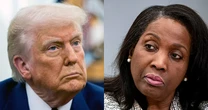An image of Donald Trump cosplaying as a football player last weekend set the tone for the final push of the Republican nominee’s campaign. It depicts Trump as a yoked, veiny-arm baller glowering from within a Steelers uniform on the field at Pittsburgh’s Acrisure Stadium. While Trump actually did attend a Steelers game during his campaign visit to Pennsylvania, it’s the AI-generated image of Football Star Trump that everyone is talking about.
The cartoonishly flattering fake photo created earned media, drove conversation connecting Trump to a key battleground state, and provided grade-A memetic fodder—all without the alarmist news cycles that often follow the more erratic flights of fancy in his rally speeches. Instead, the Steelers effigy tidily sums up Trump’s closing argument: He’s a fighter on the field and a man of the people, he’s in on the joke, and the real joke is that anyone dares doubt him.
Using artificial visuals as props has been part of Trump’s political messaging for years. He conducted his first press conference as president-elect in January 2017, standing near stacks of folders supposedly proving he would turn over all business holdings to his children—folders which looked suspiciously full of blank pages. (Reporters were not allowed to access them.) Similarly, during a 60 Minutes interview in 2020, Trump’s team presented journalist Lesley Stahl with an enormous binder allegedly containing a comprehensive healthcare plan, which Stahl claimed was bogus. In between those two bookends of his lone presidential term, Trump touted a map obviously altered with a Sharpie as evidence that his earlier inaccurate warning to Alabamans about the path of Hurricane Dorian had, in fact, been on point. (Of course, it hadn’t.)
Trump left office nearly two years before OpenAI hit the mainstream in late 2022. As his current presidential campaign kicked off early this year, there was no telling how Trump and his allies might conceivably use the visual and audio wizardry of AI to help win the election.
Ultimately, the doomsday scenario—a daily bombardment of damning, difficult-to-debunk fake footage—has yet to materialize. With less than two weeks till the election, it might not arrive at all. While AI factored into the recent disinformation campaign spreading panic about Haitians in Springfield, Ohio, this election cycle has mainly, albeit not entirely, featured good old-fashioned, artisanal disinformation. After all, why bother going through the trouble of generating AI when you can just share falsehoods on TikTok?
When Trump has used AI-generated images for explicitly political purposes, it seems to have blown back on him. After he shared fabricated photos of Taylor Swift endorsing him, he quickly distanced himself from them, probably for legal reasons. Not only did the stunt earn him scads of negative press, it apparently helped inspire Swift’s full-throated endorsement of Kamala Harris.
Trump also used AI as a political cartoon factory when he shared an Orwellian fake image depicting Harris’s DNC speech as a Communist rally. (Trump ally Elon Musk did the same thing days later, with an even sillier image.) Posts like these dignify no one involved, but they are not intended in the way many feared AI would be used in this election. Very few, if any, people saw those images and accepted as read that Harris secretly dons a Communist uniform sometimes, replete with hammer-and-sickle insignia. Most people likely understood these images as what they are: high-tech, low-effort shitposting.
Although Trump’s use of AI for unseemly mudslinging purposes may turn off some undecided voters, he’s also shared plenty of more neutral fake images like the Steelers one. He’s posted AI-generated images of himself riding a lion and nailing difficult choreo, among other activities. Such images are a cleaner way to playfully project strength than the poorly photoshopped post he shared back in August of himself and other MAGA luminaries as Justice League superheroes.
Through the use of AI, Trump (or, to be more accurate, the AI-fluent members of Trump’s team) can make himself be or do anything. It’s amazing Trump hasn’t yet shared AI visuals of himself as a cop, cowboy, and soldier, considering how prominently the Village People figure into his rally playlists, not to mention how much he enjoys adopting other jobs. Content like that seems to energize the base, who generate plenty of similar images on their own, and gives everyone else something relatively innocuous to roll their eyes at or mock. It is, in other words, a great way to keep people distracted from his policies.
Another way to do that is with projection. As of this writing, neither Harris nor her predecessor Joe Biden appears to have used AI to generate any of their campaign materials. That pesky fact did not stop Trump, however, from accusing the other side of using AI deceptively. Back in August, he claimed Harris staged a huge campaign rally in Detroit using digitally manufactured crowds. (So what if TikTokers shared video footage of the event?) Although his claims were quickly debunked, Trump still got the entire internet talking about Harris and AI for a day, rather than her then-surging momentum.
Earlier the same day that Trump shared that Steelers image, he captured national attention yet again, with a viral McDonald’s photo op. The images of the apron-clad former president presiding over a frialator bore the unreal sheen of AI, and seemingly every social media account in America felt compelled to either celebrate or mock them. Because Trump can’t help but be Trump, though, some of that conversation veered toward a lie he told about McDonald’s “disproving” Harris’s claim that she worked at Mickey D’s in her youth, and a rather telling question he dodged during the stunt, about whether he thinks fast-food workers deserve a $15-an-hour minimum wage.
None of those messy complications followed Trump sharing an AI-generated image of himself as a Steeler, however; just the gleeful celebration and the impotent mockery and the free media.
Trump has always sold his supporters a fantasy. In the era of AI, it’s a fantasy they no longer have to imagine. And for many of them, it certainly beats reality.





No comments